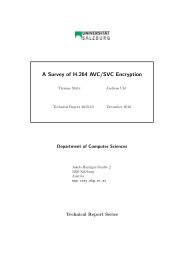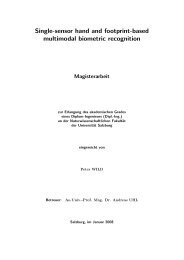Pit Pattern Classification in Colonoscopy using Wavelets - WaveLab
Pit Pattern Classification in Colonoscopy using Wavelets - WaveLab
Pit Pattern Classification in Colonoscopy using Wavelets - WaveLab
Create successful ePaper yourself
Turn your PDF publications into a flip-book with our unique Google optimized e-Paper software.
4 Automated pit pattern classification<br />
4.3.4 Centroid classification (CC)<br />
Similar to the best-basis method presented <strong>in</strong> section 4.2.1.1 this method is based on the<br />
calculation of the best wavelet packet basis too. But <strong>in</strong> contrast to the best-basis method<br />
this method is not based on features extracted from the subbands result<strong>in</strong>g from the wavelet<br />
packet decomposition but on the quadtrees result<strong>in</strong>g from the wavelet packet decomposition.<br />
The idea beh<strong>in</strong>d this method is the question whether images decomposed us<strong>in</strong>g the<br />
wavelet packets algorithm <strong>in</strong> conjunction with the best-basis algorithm result <strong>in</strong> decomposition<br />
trees which can be further used for classification. A perfect classification would<br />
then be possible if trees of one image class are more similar than trees result<strong>in</strong>g from images<br />
of different classes. In other words, the similarity between trees of the same class must<br />
be much higher than the similarity of trees of different classes to be able to perform some<br />
useful classification.<br />
The similarity of two quadtrees can be expressed by the distance between them as expla<strong>in</strong>ed<br />
<strong>in</strong> section 4.3.1.<br />
It is worthwhile to mention that hav<strong>in</strong>g a method to express the distances between two<br />
quadtrees we could easily use that distance measure for a k-NN classification. This is exactly<br />
what the feature extractor KNNTD (see section 4.3.3.3 above) does. S<strong>in</strong>ce we know the<br />
classes for all tra<strong>in</strong><strong>in</strong>g images, for an unknown test image we create the respective bestbasis<br />
decomposition tree and calculate the quadtree distances to all trees of the tra<strong>in</strong><strong>in</strong>g<br />
images. The class, which dom<strong>in</strong>ates over the k nearest tra<strong>in</strong><strong>in</strong>g images is then assigned to<br />
the unknown tra<strong>in</strong><strong>in</strong>g image.<br />
Now, hav<strong>in</strong>g a method to express the distance between two quadtrees and a set of images<br />
I T used for tra<strong>in</strong><strong>in</strong>g, first of all the distances between all possible pairs of quadtrees of<br />
images out of this set are calculated as follows<br />
d i,j = d(T i , T j ) i, j ∈ {1, . . . , n} (4.58)<br />
where T i and T j are the decomposition trees of the i-th and the j-th image respectively, n is<br />
the number of images <strong>in</strong> I T and d is the quadtree distance metric used. I Tc is the subset of<br />
I T which conta<strong>in</strong>s all images of class c.<br />
I T = I T1 ∪ I T2 ∪ · · · ∪ I TC (4.59)<br />
where C is the total number of classes of images.<br />
The trees T i and T j , as stated above, are the result of the best-basis algorithm and are the<br />
optimal basis for the respective images <strong>in</strong> respect to a certa<strong>in</strong> cost function such as the ones<br />
listed <strong>in</strong> section 4.2.1.1.<br />
The distances d i,j obta<strong>in</strong>ed above are now used to construct a distance matrix D of size<br />
n × n with<br />
d Ti ,T i<br />
= 0 ∀i = 1, . . . , n (4.60)<br />
54








